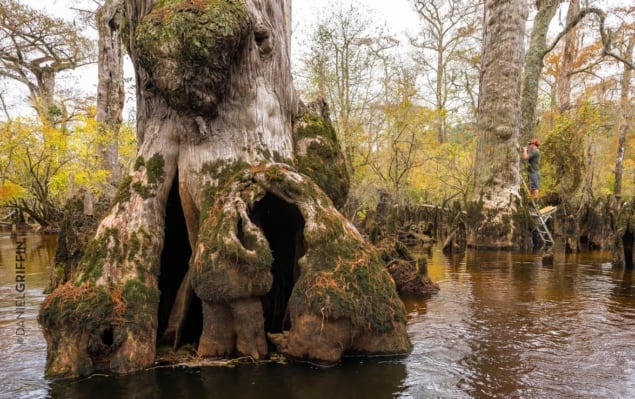
Some bald cypress trees in the US state of North Carolina are more than 2000 years old, according to a recent study, making them the oldest known trees in eastern North America. The presence of such ancient trees should support efforts to protect their habitat from logging and development.
Researchers taking core samples from trees in the Black River wetland forest found several trees over 1000 years old, including one that sprouted before 605 BCE.
As a rule, the age of a tree is reflected in the number of concentric rings within its trunk. In late spring and early summer, trees grow quickly, producing a layer of new wood just beneath the bark. Later in the growing season, when growth has slowed, new wood forms a denser, thinner layer. Each pair of layers constitutes a single annual growth ring; its thickness depends on how favourable conditions were that year.
In the Black River study, the tree rings revealed a strong correlation between growth rate and the amount of precipitation during the growing season.
The oldest trees in the world are dominated by species found in the western US, such as the giant sequoia that can live for more than 3000 years and the Great Basin bristlecone pine that can survive for 5000 years. Ring thicknesses in such individuals offer an unbroken record of local climatic conditions going back millennia. Until now, the oldest trees known in the east of the continent were 1000-year-old bald cypress; this study extends the climate proxy record in the region by more than 900 years.
David Stahle of the University of Arkansas, US, and colleagues from The Ancient Bald Cypress Consortium, Cape Fear River Watch, University of Minnesota, The Nature Conservancy and United States Geological Survey searched the 6400-hectare Black River Preserve for trees showing obvious signs of age. The researchers took radial cores from likely candidates — causing no significant harm — and confirmed their age using radiocarbon dating.
After accounting for what Stahle calls “part of the ‘Black Arts of Dendrochronology’” –the tendency of trees to grow more slowly with age— the researchers had a sample from the oldest individual that, in principle, recorded growing conditions over 2624 years. (Core samples are extracted a few metres above the ground, where rings are undistorted by the tree’s basal swell, so the true age of this tree is probably 50 years greater.)
To test the record’s reliability, Stahle and colleagues measured the correlation between ring thickness and early-growing-season precipitation in the region between 1895 and 2010. They also studied the correlation between the ring thickness and patterns of atmospheric pressure over North America, the Atlantic and the Pacific.
About half of the variance in measured precipitation could be explained by growth-ring thickness, suggesting that the cores are a useful indicator of early-growing-season conditions over the past two millennia. Ring thickness also correlated with large-scale patterns of atmospheric pressure, which the researchers associate with cycles of the Pacific–North American circulation. This phenomenon influences bald cypress growth rate through its effect on local temperature.
The oldest tree currently known is one of just 404 dated so far. “There are many thousands of old-growth bald cypress — and water tupelo — yet to be studied at Black River, so the possibility of finding at least one 3000-year-old bald cypress cannot be ruled out,” says Stahle.
The record could be pushed back even further than this, however.
“Old ‘sub-fossil’ or relic logs found on the swamp floor or preserved in the main channel of the stream can sometimes be cross-dated with the chronology based on living trees, improving and extending the chronology deeper into prehistory,” says Stahle. “Remnant sub-fossil wood has been used to produce many of the longest tree-ring chronologies on Earth, including the pine chronologies from northern Fennoscandia and the bristlecone pine chronologies of the Great Basin.”
Stahle and colleagues reported their findings in Environmental Research Communications.



